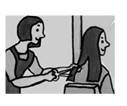Traditionally, sole custody to the mother was the only option considered by the courts for divorcing parents. More recently, over half of the states have enacted legislation authorizing joint custody. About 16 percent of separated/divorced couples actually have a joint custody arrangement. In a typical joint custody arrangement, the parents continue to live in close proximity to each other. The
children may spend part of each week with each parent or may spend alternating weeks with each parent. One potential disadvantage of joint custody is that it tends to put hostile ex-spouses in more frequent contact with each other, and the marital war continues. Children do not profit from being subjected to bickering, yet relationships between children and bickering parents are not significantly different from those between children and parents who do not have joint custody. In a national study of children whose parents had a joint custody arrangement, the researchers found no evidence of less conflict or better relationships with their parents than if the children lived with one parent and saw the other on a visitation basis. California, confronted with evidence that joint custody is not always in the best interest of children, has rescinded its 1979 law of "presumptive joint custody." Joint custody has a positive side, however. Ex-spouses may fight less if they have joint custody because there is no inequity in terms of their involvement in their children's lives. Children will benefit from the resultant decrease in hostility between parents who have both "won" them. Unlike sole-parent custody, in which one parent (usually the mother) wins and the other parent loses, joint custody allows children to continue to benefit from the love and attention of both parents. Children in homes where joint custody has been awarded might also have greater financial resources available to them than children in sole-custody homes-fathers awarded joint custody are more likely to pay child support. The second sentence of the first paragraph ("More recently, over half of the states..." is a statement of
a. opinion.
b. fact.
B
You might also like to view...
Which of the following types of supporting details are commonly used in information reading?
a. facts and statistics b. examples c. quotations d. all of the above
Dans sa comédie, Jamel Debbouze aime parler des différences culturelles entre les Français et
a. … les Québécois. b. … les Suisses. c. … les Nord-Africains
PASO 2. Los planes de Rosa.Rosa has finally decided to spend her holidays in Santiago de Chile. Now she is telling Analía all her plans for her journey there. Complete her description with the future of the verbs in parentheses.
Mi vuelo (salir)______________ muy temprano, así que yo (tener) ______________ que levantarme a las cuatro para llegar al aeropuerto antes de las seis. Mi hermano, quien va a acompañarme, me (encontrar) ______________ en el aeropuerto. A las nueve, (llegar) ______________ en Santiago de Chile. Desde el aeropuerto, (alquilar) ______________ un carro para conducir a nuestro hotel. Para el primer día, yo (querer) ______________ explorar la ciudad a pie, pero yo sé que mi hermano (decir) ______________ que tiene sueño y él (quedarse)______________un rato en el hotel. Entonces (irse) ______________ sola y (caminar)______________ por las calles hasta que mi hermano se despierte.? Fill in the blank(s) with the appropriate word(s).
Escoge la profesión que corresponda a cada dibujo.

a. gerente
b. maestro(a)
c. peluquero(a)